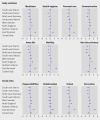Participation in life situations of 8-12 year old children with cerebral palsy: cross sectional European study
- PMID: 19395424
- PMCID: PMC2673343
- DOI: 10.1136/bmj.b1458
Participation in life situations of 8-12 year old children with cerebral palsy: cross sectional European study
Abstract
Objectives: To evaluate how involvement in life situations (participation) in children with cerebral palsy varies with type and severity of impairment and to investigate geographical variation in participation.
Design: Cross sectional study. Trained interviewers visited parents of children with cerebral palsy; multilevel multivariable regression related participation to impairments, pain, and sociodemographic characteristics.
Setting: Eight European regions with population registers of children with cerebral palsy; one further region recruited children from multiple sources.
Participants: 1174 children aged 8-12 with cerebral palsy randomly selected from the population registers, 743 (63%) joined in the study; the further region recruited 75 children.
Main outcome measure: Children's participation assessed by the Life-H questionnaire covering 10 main areas of daily life. Scoring ignored adaptations or assistance required for participation.
Results: Children with pain and those with more severely impaired walking, fine motor skills, communication, and intellectual abilities had lower participation across most domains. Type of cerebral palsy and problems with feeding and vision were associated with lower participation for specific domains, but the sociodemographic factors examined were not. Impairment and pain accounted for up to a sixth of the variation in participation. Participation on all domains varied substantially between regions: children in east Denmark had consistently higher participation than children in other regions. For most participation domains, about a third of the unexplained variation could be ascribed to variation between regions and about two thirds to variation between individuals.
Conclusions: Participation in children with cerebral palsy should be assessed in clinical practice to guide intervention and assess its effect. Pain should be carefully assessed. Some European countries facilitate participation better than others, implying some countries could make better provision. Legislation and regulation should be directed to ensuring this happens.
Conflict of interest statement
Competing interests: None declared.
Figures
Comment in
-
Childhood disability and social policies.BMJ. 2009 Apr 24;338:b1020. doi: 10.1136/bmj.b1020. BMJ. 2009. PMID: 19395423 No abstract available.
References
-
- United Nations. Convention on the rights of the child. New York: United Nations, 1989. - PubMed
-
- United Nations. Convention on the rights of persons with disabilities. Resolution 60/232. Adopted 13 December 2006. New York: United Nations, 2006.
-
- World Health Organization. International classification of functioning, disability and health. Geneva: WHO, 2001.
-
- World Health Organization. World Health Organization classification of functioning, disability and health. Children and youth version. Geneva: WHO, 2007.
-
- McConachie H, Colver AF, Forsyth RJ, Jarvis SN, Parkinson KN. Participation of disabled children: how should it be characterised and measured? Disabil Rehabil 2006;28:1157-64. - PubMed

